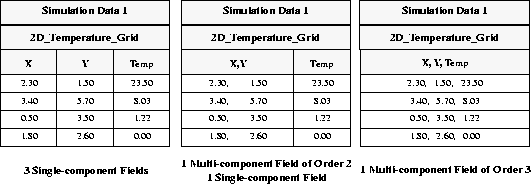FIGURE 4a - Vdata Table Structure

4.2.1 Records and Fields
Each record in a vdata is composed of one or more fixed-length fields. Vdata records and fields are identified by an index. The record and field indexes are zero-based and are separately incremented by one for each additional record and field in the vdata.Every field in a vdata is assigned a data type when the vdata is created. The data type of a field may be any basic HDF data type: character, 8-bit, 16-bit, and 32-bit signed and unsigned integers, and 32-bit and 64-bit floating point numbers. The maximum length of a vdata record is 32,767 bytes.
The Vdata model allows multiple entries per field as long as they have the same data type. The number of entries or components in a field is called the order of the field.
The organizational structure of a vdata is often determined by the data types of its data set or sets. For example, given a data set describing the location ("X,Y") and temperature ("Temp") of points in a plane, there are several ways to organize the data. (See Figure 4b.) If the "X", "Y" and "Temp" values are of the same data type, they could be stored as three single-component fields, as a two-component "X,Y" field and a single-component "Temp" field, or as a three-component "X,Y,Temp" field. Generally the "X,Y" data is stored in a single field, but HDF places no restrictions on the organization of field data and there are no significant HDF performance issues involved in choosing one organizational regime over another.
